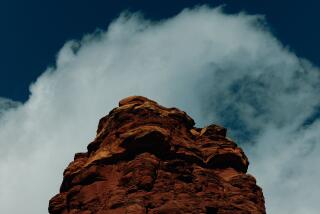Shifting Sands of Time
- Share via
The delicate, intermittent scraping sounds coming from a corner of the Irvine Barclay Theatre lobby are the first signs that something unusual is going on.
Four young Tibetan monks in long red skirts and sleeveless tops are leaning over each side of a small table, gently coaxing colored sand from slender copper funnels called chak-pur. Each monk rubs a metal rod across the skinny ribs of a funnel, painstakingly directing a thin stream of sand into the intricately disciplined patterns of a mandala, symbol of the cosmos.
On Tuesday afternoon, the rich greens, blues, reds and yellows of the central design were already in place. Peering over the shoulder of a monk--his face nearly level with the table, his forearm steadied on an oblong green pillow--a visitor sees white curving lines gradually appear on a blue background, like icing piped from a pastry bag. The massed grains of sand give the roughly 4-foot-square pattern a dense, tactile quality.
Working six hours a day in Irvine since Tuesday morning, members of Drepung Loseling Monastery in India continue a tradition that began some 15,000 years ago. Mandalas are used as objects of meditation to help purify the earth and its inhabitants.
The monks can be observed completing their handiwork from noon to 4 p.m. today in person or on the World Wide Web (https://www.ocnow.com). The sand mandalas are part of “The Mystical Arts of Tibet,” a program of Tibetan sacred music and vividly costumed, masked dance that has been touring the world for a decade. (Performances at the Barclay--a condensed version of the traditional days-long rites--are tonight and Saturday afternoon.)
The otherworldly quality of the performances derives from the way each monk simultaneously intones three notes of a chord and from the traditional instruments that include 10-foot-long horn trumpets, cymbals, bells and drums.
Stunning though they are, sand mandalas are destroyed soon after their creation, reflecting the impermanence of life. Half the sand is distributed to onlookers in need of healing; the other half is sprinkled on a body of water, to be carried to other parts of the world.
While the healing aspects of these rites may appeal to world-weary Westerners, and though recordings of temple music have made the New Age charts, the monks’ tour is grounded in harsh political realities.
In 1959, during the Chinese invasion of Tibet, the monastery’s 543-year history--as well as that of thousands of other Buddhist enclaves--was brutally terminated when thousands of monks were massacred or imprisoned in concentration camps.
A small band of emigres from the southeastern Tibet monastery reached a village near Lhasa, where they formed a religious community in refugee camps. Eight years ago, U.S. sympathizers founded the nonprofit Loseling Institute in Atlanta--now an affiliate of Emory University--to support Tibetan Buddhists in exile and provide information about their teachings. Gift items for sale at the Barclay and an educational fund for monks in training are part of this effort.
Beyond its entertainment value, beyond even its spiritual balm, “The Mystical Arts of Tibet” represents what may be the last gasp of an endangered culture its future as uncertain as grains of colored sand flowing down the Santa Ana River.
* Public viewing of the sand mandala at the Irvine Barclay Theatre lobby from noon to 4 p.m. today; closing ceremonies and dismantling of the mandala at 1 p.m. Saturday. Free. “Mystical Arts of Tibet” performances tonight at 8 (limited availability) and Saturday at 4 p.m. $24-$28. Sponsored by the Philharmonic Society of Orange County and the Irvine Barclay. (949) 854-4646.
More to Read
Sign up for The Wild
We’ll help you find the best places to hike, bike and run, as well as the perfect silent spots for meditation and yoga.
You may occasionally receive promotional content from the Los Angeles Times.






